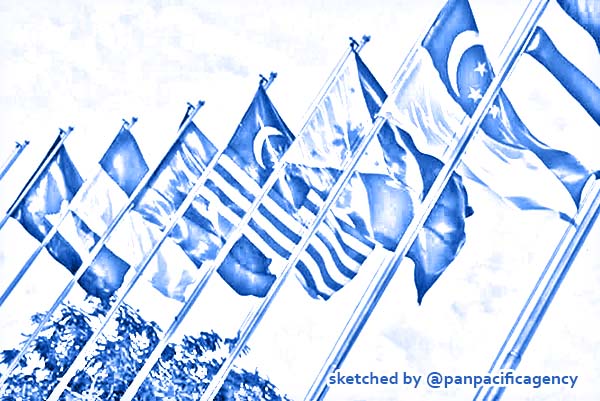[Analytics] A China management strategy with ASEAN at its centre

The Association of Southeast Asian Nations mistakenly posted a Philippine flag with the red field on top in its greeting on the country's 121st Independence Day. Sketched by the Pan Pacific Agency.
China may be misreading the COVID-19 pandemic as an opportunity to cover ground on some of its medium-term objectives. At the same time, the United States seems determined to not give way to the Chinese ambition to strategically dominate the Indo-Pacific region. Frederick Kliem specially for the East Asia Forum.
Regional middle powers like Australia and India are nervous about Chinese assertiveness, leaving smaller Southeast Asian countries unsure whether they can maintain their strategic preference of not choosing sides.
The consequence is an increasingly tense Indo-Pacific region with smaller ASEAN member states at the epicentre. They have much to lose should tensions between China and the Quad partners — the United States, India, Japan and Australia — further escalate. The Indo-Pacific region is in need of a new strategic balance through strategy to manage, not contain China’s rise. ASEAN fulfils a critical function.
China and India’s growing footprint in regional geopolitics has meant that the Indo-Pacific region has become a contested strategic space.
The Quad partners are determined to push against Chinese military aggression and extension of regional influence. Since 2017 the Quad has stepped up cooperation with converging visions for a free and open Indo-Pacific (FOIP). Quad meetings moved from the official to the ministerial level with a recent table-top exercise, followed by two parallel operations-based naval-exercises.
Following the rapid deterioration of India–China relations, New Delhi might be more easily persuaded to join an anti-China balancing coalition, abandoning its tradition of non-alignment. Evidence for this trend includes closer diplomatic and military relations with individual Quad countries and suggestions by Indian political elites to rethink traditional diplomatic beliefs and practices. A key step in this direction would be for the Quad permanently institutionalise joint operational exercises, turning India’s Malabar naval-exercise into a de facto Quad exercise.
The COVID-19 pandemic has accelerated economic and diplomatic de-coupling from China by Quad governments. Governments incentivised businesses to diversify away from China and Chinese supply chains and decreed bans on security-relevant Chinese products. Current trends suggest that Quad and FOIP visions will entrench a strategic anti-China framework.
While the pandemic presents a challenge to multilateralism, it also shows how decades of physical globalisation have deepened international interdependence. Despite nascent bloc-formation, many countries in the region still value close trade relations with China. China is deeply entrenched in all structural elements of the Indo-Pacific, including free trade agreements, supply chains and investment projects.
The COVID-19 pandemic has also demonstrated that future challenges will require Chinese cooperation. Challenges like the future of freshwater supply in the region — China controls upstream seven of Asia’s largest rivers — will require close cooperation and negotiation with Beijing.
Quad members are determined to not continue business as usual as Beijing increases its assertiveness. But classical containment of China is short-sighted and unlikely to be a policy success. A sustainable China management strategy can be built on two pillars: facilitating communication and economic exchange where possible and constraining China militarily and within international institutions where necessary.
Greater strategic alignment among Quad members is necessary to push against ambitious Chinese aggression. But this alone is insufficient. There is an additional need for diplomatic, economic and information instruments. A balanced strategy must be anchored in an Indo-Pacific multilateral architecture that can keep the region engaged and interdependent, and allow both sides to communicate and negotiate mutual red lines.
Such multilateralism should be facilitated by ASEAN, which has the necessary mechanisms and preconditions in place.
Since the mid-1990s, ASEAN has been successful in hosting large scale regional multilateral events including the East Asia Summit and the ASEAN Defence Ministers’ Meeting-Plus. ASEAN’s role in the extensive web of regional multilateralism has culminated in ASEAN’s centrality and its convening power.
Beijing values its relations with ASEAN. Sino-Southeast Asia relations include deeply entrenched trade relations and large-scale investment projects. There is also an underappreciated ideological component to Chinese interests in Southeast Asia. Chinese President Xi Jinping’s vision of an indigenously-led region without external interference must include Southeast Asia. But the recent chairman’s ASEAN summit statement suggests that ASEAN leaders are increasingly irritated by Chinese unilateralism.
ASEAN welcomes continued US engagement in the Indo-Pacific region but rejects Washington’s neo-mercantilism and ‘America First’ nationalism. This has been marked by strategically unsavvy measures like abandoning the Trans-Pacific Partnership.
ASEAN leaders know they need both China and the Quad for immediate COVID-19 recovery and for the future prosperity of the region. While irked by Beijing’s unilateralism, China is an inevitable part of Asia’s future and ASEAN members have an intrinsic and urgent interest in contributing to a new Indo-Pacific equilibrium. Should ASEAN fall back on its traditional default wait-and-see approach, it risks the entrenchment of binary Quad–China confrontation, which would force ASEAN members to choose sides.
Instead, ASEAN can legitimately claim to be an honest broker, not being firmly on either side.
With the Regional Comprehensive Economic Partnership between the ASEAN countries and five regional partners, ASEAN will sit at the centre of regional economic interdependence. ASEAN becomes the hinge that keeps the economic growth of all regional economies tied to China’s success. But it is also an unambiguous signal that ASEAN values free trade and strives to increase interdependence rather than de-coupling from China.
ASEAN needs to do more. It must leverage its position and mitigate Quad–China rivalry by managing effective communication between the two sides. This would elevate ASEAN centrality to a higher level and turn it from a convener into a proactive moderator of a new Indo-Pacific equilibrium.
Frederick Kliem is a fellow at the S Rajaratnam School of International Studies, Nanyang Technological University.